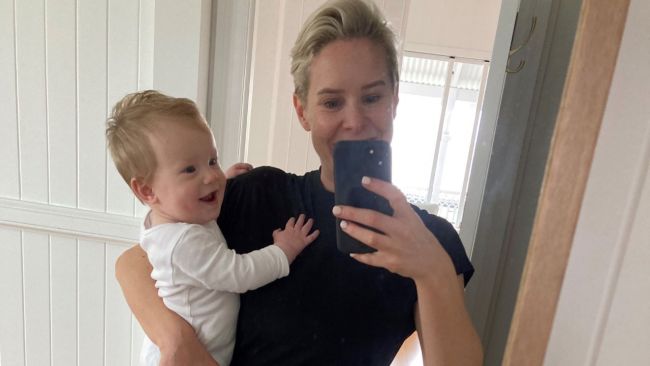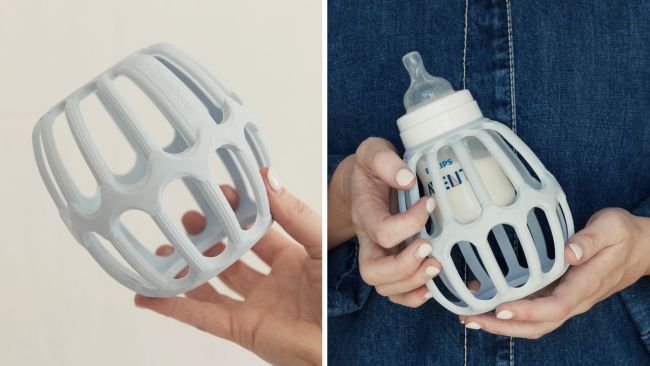‘My maternity leave side hustle pulled me out of PND’
After battling her newborn's challenging feeding schedule, a Brisbane mum’s invention completely changed her life.
First time motherhood for Harriette didn’t begin anything like she imagined.
Following a miscarriage, then being unwell throughout her second pregnancy, the Sydney mum struggled to breastfeed her baby girl, Penelope, due to latching issues.
After six weeks of breastfeeding and pumping around the clock, the Brisbane mum had reached her limit.
“It was so mentally and physically taxing that my mental health had started to go downhill,” the 36-year-old tells Kidspot.
“Every pump, every feed I was constantly worried if she was getting enough milk and I was obsessively tracking everything she did. It was another reminder that I was failing. There are photos of me smiling with my baby socialising but my internal experience was quite dire.”
Want to join the family? Sign up to our Kidspot newsletter for more stories like this.

At eight weeks postpartum, Harriette was diagnosed with post natal depression (PND), which validated what she was feeling and she was able to seek help through therapy.
“It got so bad once that I had a full blown panic attack as I was convinced Penelope wasn’t breathing while she was napping and I even called an ambulance,” she remembers.
“I didn’t feel equipped to care for this child and keep her well.”
Penelope was perfectly healthy, but Harriette’s PND continued to cast a dark cloud over her first nine months of parenting.
“This negative mum guilt started because she was a healthy baby who slept, and I had a roof over my head and I was so critical of myself, that I shouldn’t be feeling so low,” she says honestly.
RELATED: I would bottle feed her under my breastfeeding cover
Fed is best
Switching to formula feeding when Penelope was two months old after consultations with a lactation consultant added to Harriett’s feelings of guilt.
“I changed (to formula) because I felt that I should, but all the while I was hating it,” she admits.
“I had some comments that were insensitive for me at the time with people asking, “Oh, is that breast milk in her bottle?’”
For Harriette’s daily life, however, the transition to bottle feeding was instrumental in helping her function better as a mum who needed to be back at work part time in her own real estate business after just a couple of months of maternity leave.
“It meant being free of the schedule of constantly feeding and pumping and cleaning the equipment,” she says.
“It gave me more time to spend with Penelope or to eat a proper meal. And she was thriving, so I’d actually started to enjoy motherhood, and we began to go out more.”

A lightbulb moment and a clever idea
It was during a postnatal pilates class when Penelope was just over three months old, that Harriette’s lightbulb moment came.
“I was there in an attempt to try to feel good about myself and my body and connect with other mums, but I had to stop for a feed and wondered if there was a way to solve this issue,” she explains.
“Later on, I saw someone using a bottle holder for their baby, and because Penelope was already grabbing things by then, I tried to buy one but couldn’t find it anywhere.”
That sprung the determined mum into action in researching and creating one of her own with the help of a Brisbane manufacturer.
By the time Penelope was nine months old, Harriette already had her first prototype to test out - and the results were a complete gamechanger.
“After I’d had a rough night with her, I would go for a walk with other mums while pushing the pram, and I didn’t need to stop to give her a feed,” she says happily.
“She did it completely by herself while I kept a close eye on her if she happened to need any help. She couldn’t hold a bottle on her own but she could do it using the helper. It was amazing. After that, she could sit in the bouncer next to my desk and have her feed while I worked on our businesses. If she needed comfort, I could hold her and still have a hand free as she was holding the bottle.”
After two years of product testing and Harriette investing a whopping $125,000 of her savings, the babybotbot Bottle Helper was launched in February. Retailing at $59.95, it fits eight different brands of baby bottles and is made from recycled plastic and has a texture similar to silicone.
The product has been independently tested and meets all safety standards for babies to use from three months old.
“There’s an inbuilt safety mechanism that means if they can put it to their mouth, they can pull it away,” Harriette explains.
“It’s important to look for those cues for their skills in grasping at the time.”
Harriette emphasises the Bottle Helper doesn’t provide a means for parents to leave their baby feeding unattended.
“We advise while using it that you are always within arm’s reach of the baby for the entire feed and supervising.”

RELATED: The simple activity that could help reduce PND
Divided opinions
While the majority of feedback for babybotbot has been positive, it hasn’t been without its critics.
In the comments section of a social media ad which encouraged parents to use the product “guilt free” if they wished to go down that feeding route, Harriette was disheartened to read one negative comment which said, “Wouldn’t a mother feel more guilty for not holding her baby? Why are you forcing the baby to grow up?”
It was a reaction she was more than ready for.
“I realise there are a lot of parents wondering, ‘Is this okay? Should I use a shortcut” but I wanted to create a brand and community that says, ‘You know you love your baby and you’re doing your best,” she says passionately.
“Whatever way you decide to do it, if it’s informed and considered, then it’s the right decision. No one else has a right to impose their judgement’. I can handle those comments because I know I’m doing the right thing.”
While she has high ambitions for her first year in business, creating the product has already been life changing in the most positive way imaginable in helping her heal from PND.
“There were definitely highs and lows, but I lost a lot of myself when I became a mum, and this brought together who I was before with my experiences in motherhood, giving me self confidence again in everything I did,” she says.
“I just want to help mums juggle everyday life a little easier, and make it possible for them to do the things they would love to do with a baby.”
More Coverage
Originally published as ‘My maternity leave side hustle pulled me out of PND’





